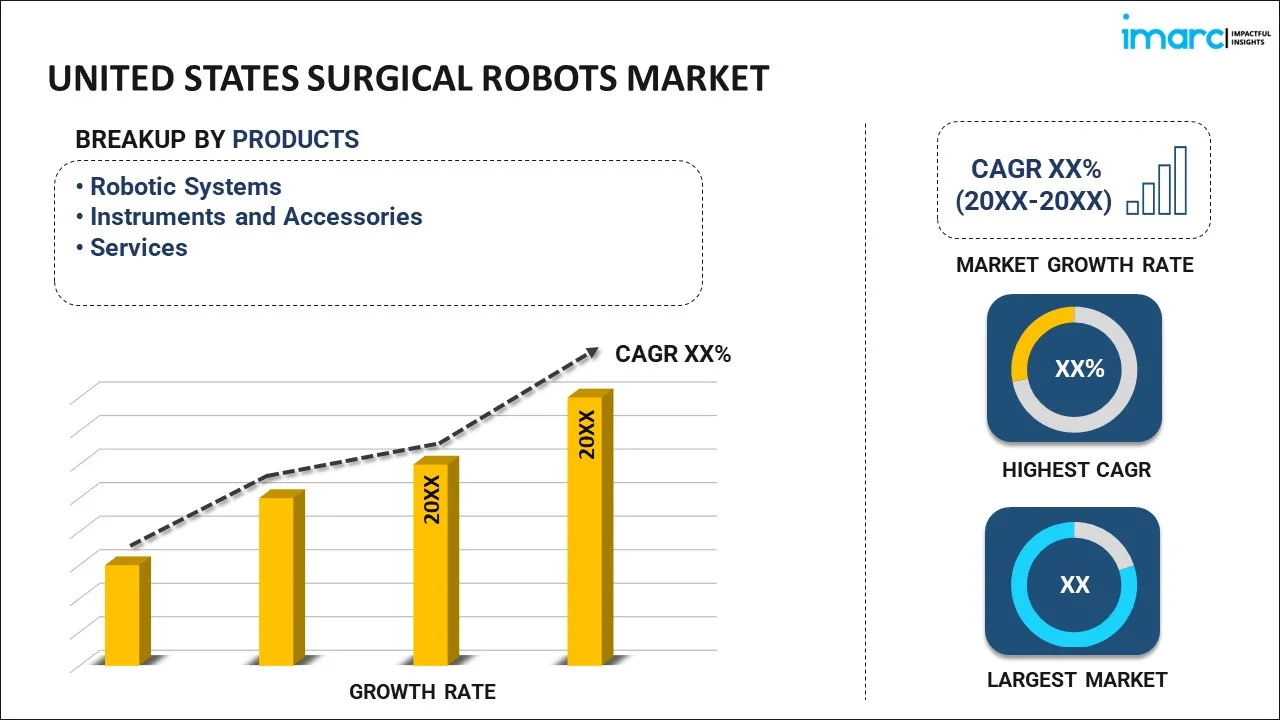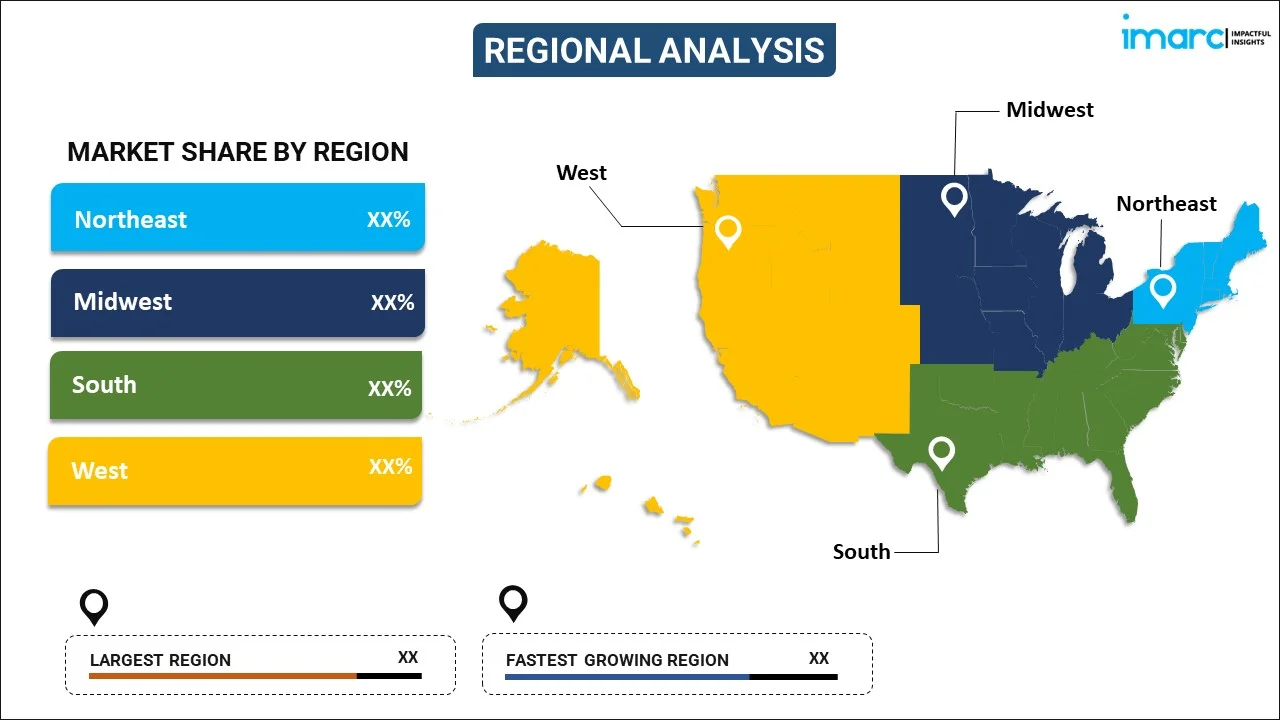
United States Surgical Robots Market Report by Product (Robotic Systems, Instruments and Accessories, Services), Application (Gynecological Surgery, Urological Surgery, Neurosurgery, Orthopedic Surgery, and Others), End User (Hospitals, Ambulatory Surgical Centers, and Others), and Region 2025-2033
Market Overview:
United States surgical robots market size reached USD 21.5 Billion in 2024. Looking forward, IMARC Group expects the market to reach USD 42.4 Billion by 2033, exhibiting a growth rate (CAGR) of 7.8% during 2025-2033. The increasing demand for minimally invasive (MI) surgeries, significant advancements in robotic technology, rising aging population, expansion of telemedicine, heightened awareness of robotic-assisted surgery benefits, and investments in research and development (R&D) represent some of the key factors driving the market.
|
Report Attribute
|
Key Statistics
|
|---|---|
|
Base Year
|
2024 |
|
Forecast Years
|
2025-2033
|
|
Historical Years
|
2019-2024
|
| Market Size in 2024 | USD 21.5 Billion |
| Market Forecast in 2033 | USD 42.4 Billion |
| Market Growth Rate (2025-2033) | 7.8% |
Surgical robots are advanced technological systems designed to assist surgeons in performing a variety of medical procedures with precision, flexibility, and control. These robots are equipped with robotic arms, cameras, and sophisticated software that enable surgeons to conduct minimally invasive surgeries (MIS) with enhanced accuracy. Utilizing a console with hand controls, surgeons can manipulate the robotic arms, which carry specialized surgical instruments, providing a high degree of dexterity and maneuverability in tight spaces. The integration of advanced technologies, such as artificial intelligence (AI) and haptic feedback systems, enhances the surgeon's ability to perform complex procedures with improved precision and efficiency. Surgical robots have become instrumental in various medical fields, including urology, gynecology, orthopedics, and general surgery, offering benefits, such as reduced scarring, quicker recovery times, and minimized trauma for patients. As these systems continue to evolve, incorporating innovations like virtual reality (VR) and teleoperation, they are transforming the landscape of modern surgery, making procedures more accessible and less invasive, and contributing to advancements in healthcare delivery.
United States Surgical Robots Market Trends:
The increasing prevalence of MIS in the United States represents the key factor driving the market growth, as surgical robots enable precision and dexterity in confined spaces, reducing patient trauma and recovery times. Besides this, the growing aging population, coupled with rising chronic diseases, is amplifying the demand for surgical procedures, and robotic systems offer enhanced surgical capabilities, creating a favorable outlook for market expansion. Moreover, ongoing advancements in robotic technology, including improved sensors, AI, and haptic feedback systems enhancing the efficiency and safety of surgical procedures, are providing an impetus to the market growth. In line with this, the surge in demand for telemedicine and remote surgeries is aiding in market expansion, as surgical robots enable surgeons to operate from a distance, improving access to specialized healthcare services. Concurrently, the escalating awareness of the benefits of robotic-assisted surgery, such as reduced blood loss, shorter hospital stays, and quicker recovery times, is increasing patient and surgeon acceptance, thereby strengthening the market growth. In addition to this, the rise of medical tourism in the United States, as international patients seek cutting-edge robotic surgical interventions, is acting as another significant growth-inducing factor. Furthermore, the growing integration of VR and augmented reality (AR) technologies into surgical robots revolutionizing preoperative planning and intraoperative guidance is attracting surgeons and patients, which, in turn, is positively impacting the surgical robot market. Apart from this, the increasing investment in research and development (R&D) by market players resulting in the introduction of more sophisticated and specialized robotic surgical systems is presenting lucrative opportunities for market expansion.
United States Surgical Robots Market Segmentation:
IMARC Group provides an analysis of the key trends in each segment of the market, along with forecasts at the country level for 2025-2033. Our report has categorized the market based on product, application, and end user.
Product Insights:

- Robotic Systems
- Instruments and Accessories
- Services
The report has provided a detailed breakup and analysis of the market based on the product. This includes robotic systems, instruments and accessories, and services.
Application Insights:
- Gynecological Surgery
- Urological Surgery
- Neurosurgery
- Orthopedic Surgery
- Others
A detailed breakup and analysis of the market based on the application have also been provided in the report. This includes gynecological surgery, urological surgery, neurosurgery, orthopedic surgery, and others.
End User Insights:
- Hospitals
- Ambulatory Surgical Centers
- Others
The report has provided a detailed breakup and analysis of the market based on the end user. This includes hospitals, ambulatory surgical centers, and others.
Regional Insights:

- Northeast
- Midwest
- South
- West
The report has also provided a comprehensive analysis of all the major regional markets, which include Northeast, Midwest, South, and West.
Competitive Landscape:
The market research report has also provided a comprehensive analysis of the competitive landscape. Competitive analysis such as market structure, key player positioning, top winning strategies, competitive dashboard, and company evaluation quadrant has been covered in the report. Also, detailed profiles of all major companies have been provided.
United States Surgical Robots Market Report Coverage:
| Report Features | Details |
|---|---|
| Base Year of the Analysis | 2024 |
| Historical Period | 2019-2024 |
| Forecast Period | 2025-2033 |
| Units | Billion USD |
| Scope of the Report | Exploration of Historical Trends and Market Outlook, Industry Catalysts and Challenges, Segment-Wise Historical and Future Market Assessment:
|
| Products Covered | Robotic Systems, Instruments and Accessories, Services |
| Applications Covered | Gynecological Surgery, Urological Surgery, Neurosurgery, Orthopedic Surgery, Others |
| End Users Covered | Hospitals, Ambulatory Surgical Centers, Others |
| Regions Covered | Northeast, Midwest, South, West |
| Customization Scope | 10% Free Customization |
| Post-Sale Analyst Support | 10-12 Weeks |
| Delivery Format | PDF and Excel through Email (We can also provide the editable version of the report in PPT/Word format on special request) |
Key Questions Answered in This Report:
- How has the United States surgical robots market performed so far and how will it perform in the coming years?
- What has been the impact of COVID-19 on the United States surgical robots market?
- What is the breakup of the United States surgical robots market on the basis of product?
- What is the breakup of the United States surgical robots market on the basis of application?
- What is the breakup of the United States surgical robots market on the basis of end user?
- What are the various stages in the value chain of the United States surgical robots market?
- What are the key driving factors and challenges in the United States surgical robots?
- What is the structure of the United States surgical robots market and who are the key players?
- What is the degree of competition in the United States surgical robots market?
Key Benefits for Stakeholders:
- IMARC’s industry report offers a comprehensive quantitative analysis of various market segments, historical and current market trends, market forecasts, and dynamics of the United States surgical robots market from 2019-2033.
- The research report provides the latest information on the market drivers, challenges, and opportunities in the United States surgical robots market.
- Porter's five forces analysis assist stakeholders in assessing the impact of new entrants, competitive rivalry, supplier power, buyer power, and the threat of substitution. It helps stakeholders to analyze the level of competition within the United States surgical robots industry and its attractiveness.
- Competitive landscape allows stakeholders to understand their competitive environment and provides an insight into the current positions of key players in the market.
Need more help?
- Speak to our experienced analysts for insights on the current market scenarios.
- Include additional segments and countries to customize the report as per your requirement.
- Gain an unparalleled competitive advantage in your domain by understanding how to utilize the report and positively impacting your operations and revenue.
- For further assistance, please connect with our analysts.
 Request Customization
Request Customization
 Speak to an Analyst
Speak to an Analyst
 Request Brochure
Request Brochure
 Inquire Before Buying
Inquire Before Buying




.webp)




.webp)












